|
Vol. 227 No. 7 |
| |
 |
Drilling and completion innovations deliver world-class results in Angola
Good organization, liberal use of new technologies and a "design one, build multiple" philosophy enabled ExxonMobil to rack up notable achievements offshore Angola.
Chad J. Williams and Steve S. Wilson, ExxonMobil Development Company, Houston
Several innovations achieved by the drilling team helped to deliver best-in-class results for Esso Exploration Angola Ltd.’s (Esso’s) activities on deepwater Block 15. Actions taken by the drilling team resulted in safe, environmentally sound operations that allowed production rate goals to be met or exceeded while reducing costs.
These benefits have been achieved through the successful application of 1) a centralized functional organization that maintains critical personnel continuity and promotes proven practices transfer; 2) work practices that allow the company to apply available technology effectively, and to invent technology when required; and 3) the "Design One, Build Multiple" concept, which enabled tension-leg platform (TLP) personnel to share best practices and build upon prior successes. Exceptional results have been realized in the entire cycle of Esso’s well construction process, from initial installation efforts through the drilling, completion and ongoing production operations.
BACKGROUND
Esso and its co-venturers acquired the license for Angola deepwater Block 15 in August 1994. The operator began drilling exploration wells in September 1997, discovered commercial quantities of petroleum the following year, and subsequently named the development "Kizomba A." By 1999, Esso and its co-venturers had discovered more than 1 billion bbl of oil. By December 2000, 13 exploration wells and four appraisals had been drilled in Block 15, with nine newly announced discoveries.
As with many new start-ups, getting the right people involved early was critical. The Angola Block 15 team benefited greatly from the identification and assignment of critical personnel from the Hoover-Diana (Gulf of Mexico) drilling team to key positions within the Angola Block 15 drill team.
During the concept selection phase, the development drilling team was intimately involved in the decisions to complete Kizomba A and B fields with a TLP concept, and Xikomba field with subsea architecture. These decisions were reached to reduce the development’s total life-cycle cost by allowing future reduced-cost interventions on the TLP wells while delivering the Xikomba project as efficiently as possible.
The exploration and development planning drill teams collaborated to ensure that lessons learned during the exploration/ appraisal drilling program were applied to the detailed design phase. This cooperation allowed the teams to rapidly apply proven practices and drill wells as efficiently as possible. The drilling and completion of Kizomba A, Xikomba, and Kizomba B wells proceeded very efficiently, and resulted in the team delivering wells faster than other operators – see Figs. 2 through 8. Their performance demonstrates the ability to transfer lessons learned from one project to the next, as learning curves from project to project are accelerated and enhanced.
The Block 15 drilling team had the primary goal of delivering an optimum number of high – performing, long-life wells to meet early production and injection requirements. As shown in Table 1, team members have met goals on all Block 15 projects started up to date.
| TABLE 1. Angola Block 15 well counts |
 |
|
Esso delivered the desired wells to its co-venturers and the host government on schedule, or ahead of plan. The team achieved these goals by establishing clear priorities and delivering results every day.
SAFETY PERFORMANCE
Esso transformed itself into an affiliate capable of producing in excess of 550,000 bopd by delivering three world-class developments in record time, from discovery to first oil. Esso has held, for many years, the commitment that no job is to be performed unless it can be done safely.
The outstanding drilling safety record on Block 15 has been achieved through the drilling supervisors’ dedication to promoting safety as a core value, and truly believing that all accidents are preventable with the proactive and supportive involvement of all drilling team members (employees, and drilling contractor and service company personnel).
Safety initiatives employed by the drilling team include the following:
-
- Safety leadership training for all Esso employees, and drilling contractor and service company personnel for every rig that is operated.
- Safety stand-downs and hazard hunts.
- Hand-safety programs.
- Behavior observation-based programs (STOP, Positive Intervention, Safe Behavior Recognition).
- General, daily, tour and job-specific safety meetings.
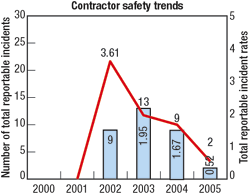 |
Fig. 1. Contractor safety trends.
|
|
These proven tools, combined with fit-for-purpose initiatives, have allowed the team to continuously improve its safety performance. A Drilling Safety Champion program instituted in Esso’s Block 15 drilling operations proactively rewards the performance of established safety programs by initiating competition between the rigs operating within that block.
The number of leading safety indicators being captured daily increased after the Drilling Safety Champion program was established. Eliminating these hazards proactively with the support of all people on location has contributed to the team’s ability to maintain a safe workplace, Fig. 1. As of Dec. 31, 2005, the rigs on both of the TLPs at Kizomba A and B had been operated without a single Lost Time Incident (LTI) since TLP drilling began on Block 15. This accounts for a combined total of over 1,050 LTI-free days.
INNOVATION DRIVING PERFORMANCE
Initial design concepts for the Kizomba A, Xikomba, and Kizomba B drilling programs were developed in 1999 and 2000 after the initial discoveries were made. Many innovations have been implemented to deliver high-quality wells at the lowest possible, total life-cycle cost. It was critical that the wells deliver the desired output, so that managers could meet the oil production targets for all Block 15 developments. The team’s ability to deliver the wells on schedule with the required oil production capacity per well was essential to the success in meeting or exceeding oil production goals.
Three approaches are applied to meet technical challenges: 1) choose and apply appropriate existing technology; 2) extend existing technology to meet situational needs; and 3) invent solutions where appropriate, justified, and necessary. A disciplined process is followed to select the most cost-effective solution for the well’s life-cycle, for a given technical application.
When existing industry technology is selected, shared global experiences help personnel understand the risks, benefits and costs of existing candidate technology. This knowledge is used to ensure that the technology will meet the need and whether the incremental risked cost is economically justified. The Angola Block 15 drilling team has endorsed and applied this philosophical approach through the practical application of the following technical innovations.
Installation successes. This group included Esso’s first use of suction embedded plate anchors (SEPLAs) in a deepwater development, to optimize mooring patterns safely run in co-existence with subsea production infrastructure. This allowed the team to deploy moored, mobile offshore drilling units (MODUs) and take advantage of lower day rates and operating expenses (when compared to a dynamically positioned drilling vessel) while also accommodating the complex subsea infrastructure required for initial installation and future planned expansion.
Another success was the industry’s first deepwater installation of 72, 30-in. structural casing strings at the Kizomba A and B projects (both TLP and subsea wells) and the Xikomba project (subsea wells). This was achieved without a template and within tight tolerances (0.5 ft, vertical, and 1.0 ft, horizontal allowable displacements).
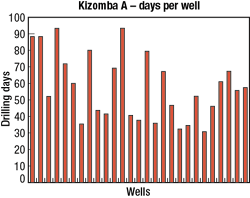 |
Fig. 2. Kizomba A days per well.
|
|
|
| |
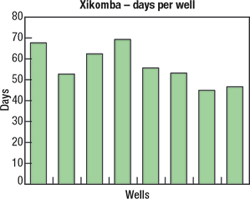 |
Fig. 3. Xikomba days per well.
|
|
|
A third achievement was the effective management of installation interfaces with minimal down-time. This resulted in the delivery of maximum volumes in the shortest possible timeframe. By effectively coordinating construction and installation schedules to avoid clashes between various stakeholders, the team was able to avoid costly downtime. Members delivered the required well capacity to Kizomba B, six months ahead of schedule.
Drilling successes. First among these achievements was the industry’s first TLP designed to minimize pulling and rerunning of the drilling riser, when operations move from slot to slot. This saved a minimum of seven days per well, Figs. 2, 3 and 4.
In addition, early identification and management of challenges provided by drilling the mass transport complexes at high (nearly horizontal) hole angles has allowed some of the world’s longest reach wells in this water depth (1,100 to 1,300 m) to be delivered. The ability to deliver these wells is allowing the benefits of the surface wellhead design concept to be realized (taking advantage of lower rig rates and lower-cost. future well interventions provided with surface tree access).
Furthermore, running subsea trees from work boats with Delmar’s heave compensated landing system (HCLS) removed this activity from the critical path and reduced Esso’s subsea well completion times by an average of two days per completion.
Finally, effective formation evaluation (FE) management was achieved. This included Esso’s first use of Baker Hughes Inteq’s TesTrak for obtaining formation pressures while drilling. In addition, the Acoustic Properties Explorer (APX) tool was used to enhance velocity/ depth conversion to improve placement of horizontal completions. Two additional items were utilized. One was implementation of MagTrak (NMR) Magnetic Resonance Logging While Drilling (LWD), to measure moveable fluids in thin bed reservoirs. The other item was the use of GyroTrak LWD to provide gyro surveys in real time, thus eliminating the need for wireline tools.
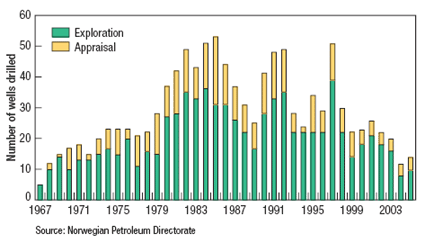 |
Fig. 4. Kizomba B days per well.
|
|
| |
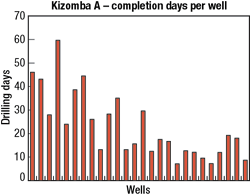 |
Fig. 5. Kizomba A completion days per well.
|
|
|
| |
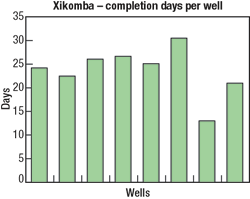 |
Fig. 6. Xikomba completion days per well.
|
|
|
| |
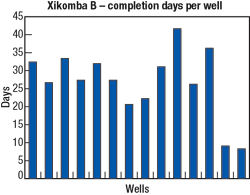 |
Fig. 7. Kizomba B completion days per well.
|
|
|
Completion successes. A significant achievement was the industry’s first installation of open-hole gravel packs in a non-aqueous drilling fluid. This resulted in roughly 100% screen installation success and greater than 100% gravel placement in open holes.
Adoption of innovative subsea completion practices reduced the total time per completion from 21 to 7 days, Figs. 5, 6 and 7. These included modified completion practices on water injectors to allow running of preinstalled plugs in horizontal trees. In addition, there were upgraded well clean-up practices. Efficiency was improved by accepting 8-1/2-in. open holes for water injection wells. Team members also ran the Polished Bore Receptacle (PBR) assembly, prepinned for single-trip installation.
Last, the team achieved the industry’s first successful shifting of a fluid shut-off (FSO) valve with the well stroker (a wireline tractor) and well key arrangement.
A specialized intellectual approach to solving engineering problems is Esso’s Engineered Wellbore, Integrated Hole-Quality (IHQ) technology.1,2 An integrated analysis of wellbore stability, hole cleaning capability, lost circulation probability, hydraulic capacity, drilling fluid design, wellbore architecture, drillstring design and operating practices delivers recommendations that optimize physical constraints and rig capabilities. This technique uses engineering fundamentals and mathematics-based analysis of trouble cost mechanisms, well cost elements and uncertainties to optimize well designs and manage unknown risks.
IHQ engineering provides the capability to better understand and meet drilling challenges presented by the mass transport complexes (MTCs) in Block 15. MTCs are assemblages of primarily mass transported and residimented material, including slumps, slides and debris flows, but also including turbidites and draping lithologies. The aggregate of numerous mass transport-dominated components is termed a mass transport complex.3 MTCs are very unstable, weak formations.
Well planning and execution processes were modified to increase drilling and completion success by performing the work with minimal nonproductive time. Some of the efforts that have been incorporated into the Block 15 work processes include the following:
-
- Predicting MTC presence in a proposed well path through seismic analysis; in general, minimizing the exposed MTC section’s length
- Developing well-specific wellbore stability models for each hole section drilled, based on near-well offset control for shale strengths
- Collecting actual formation-strength data as the well is drilled, and adjusting the required mud weight to enhance wellbore stability and increase chances of successfully drilling the well
- Enhancing future wells by applying lessons learned.
Examples of invented equipment and operational practices are Non-Aqueous Fluid (NAFPac) and Alternate Path Technology (APT).4 This solution was developed to gravel pack the Block 15 completion intervals (about 1,000 m of weak sands with interbedded weak shales) by running screens and gravel packing with Esso-invented alternate path technology. The NAFPac technique ensures that the hole is never shocked by the introduction of other fluids traditionally used for gravel packing. The use of APT technology has resulted in placement of more than 100% of the design gravel-pack volume in more than 90% of these wells. When compared to industry standards, this is a distinct and superior performance.
"DESIGN ONE, BUILD MULTIPLE" BENEFITS
Esso’s application of the "Design One, Build Multiple" project execution plan achieved significant cost savings during development of the deepwater Kizomba projects. Two fields, Kizomba A and B, were developed using TLP surface wellhead platforms (SWHPs) and predrilled wells to accelerate production of first oil.
The design included an integrated, high-capacity TLP drilling rig with innovative riser management and handling features. Close involvement between the project and operating groups ensured fit-for-purpose capability to carry out tieback, completion, and drilling programs.
To optimize well designs, drill-the-well-on-paper and planning exercises were conducted during the front end engineering and design (FEED) and detailed design phases. The inclusion of Esso and drilling contractor team members in design, construction, and commissioning activities further contributed to the efficient start-up and on-going performance achieved by the Kizomba A TLP rig, Fig. 8.
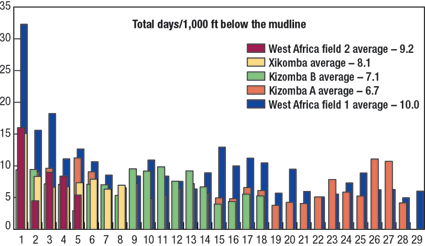 |
Fig. 8. Benchmarking analysis.
|
|
The lessons learned and experience gained on Kizomba A were transmitted directly to Kizomba B through the use of a disciplined change control process that protected the original design. Eighty-nine lessons learned were placed on an operational issues list, and these lessons (improvements) were incorporated during Kizomba B construction activities.
A direct result of increased construction efficiency realized through the "Design One, Build Multiple" project execution plan was the achievement of a greater degree of completion of the Kizomba B TLP, when the site integration test was conducted. A comparison of data from initial activities on the Kizomba A and B TLPs demonstrates that a more capable drilling operation was executed on the second start-up operation. Specifically, a 26% reduction in execution time for installation of the initial production riser tiebacks and the pre-drill well upper completions was achieved on Kizomba B, Figs. 9 and 10.
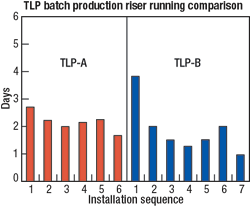 |
Fig. 9. TLP batch production riser running comparison.
|
|
|
| |
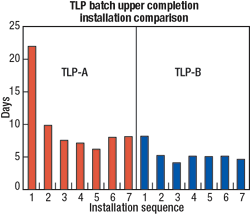 |
Fig. 10. TLP batch upper completion comparison.
|
|
|
MANAGING POSITIVE COST PRESSURE
As with many major projects, managing positive cost pressure is a continuous challenge. This challenge has been effectively addressed in the Block 15 developments to date. To minimize upward cost pressures, the drilling team implemented the following actions at the early stages of the project, and these actions remain in place today:
-
- Hold effective cost-reduction workshops with involvement of co-venturers and the host government.
- Identify, implement and track the progress of 32 specific innovations to reduce project cost. Key cost-reducing initiatives include 1) maximizing batch operations; 2) installing slim-bore wells whenever possible; 3) installing subsea trees offline, and 4) implementing LWD technology to acquire formation pressure data.
- Communicate effectively with other organizations (Esso’s logistical support personnel, project and production staff; third-party contractors, and other operators) to reduce overall equipment and services requirements while meeting drilling team requirements.
One specific innovation implemented was removing the installation of the horizontal subsea trees from the critical path on the rig, and allowing the trees to be run without the drilling rig from the back of workboats, with the use of an HCLS. (This technique was initially utilized by ExxonMobil’s drilling team in the Gulf of Mexico and was shared between teams.) Nineteen subsea trees have been successfully installed with the HCLS.
Another significant cost reduction achievement was the elimination of 20-in. casing from 52% of the wells drilled to date on the Kizomba A, Xikomba, and Kizomba B projects. In the original funding design, all wells were assumed to require four casing strings. The team challenged this design concept, however, and redesigned the wells with three casing strings while managing the increased drilling risk. The three-casing-string design wells, referred to as slim-bore wells, do not run 20-in. casing. Slim-bore well candidates are selected, based upon riserless directional control capabilities and directional drilling requirements, as well as predicted formation pressures.
The application of a robust cost management process, incorporating identification, application and stewardship of cost-reduction initiatives, has mitigated market-driven increases in drilling costs. At this time, the Kizomba A and B drilling programs anticipate savings of $400 million from 32 identified-and-measured ongoing cost-reduction initiatives.
CONCLUSIONS
Esso has delivered improved results by applying existing technology that meets project needs, extending available technology successfully with thorough evaluation of the risks and benefits of the extension, and inventing technologies when available systems cannot meet those needs.
Successful execution of innovative solutions has allowed production rate goals to be met or exceeded while reducing costs. The result is delivery of the most cost-effective wells that complement the long-term objectives of the projects operated in Angolan Block 15. 
This article is based on OTC paper 17955-PP, presented at the 2006 Offshore Technology Conference in Houston, Texas, May 1 – 4, 2006.
ACKNOWLEDGEMENTS
The authors would like to thank Sonangol for granting the concession to develop and operate Block 15. They also thank co-venturers BP, ENI and Statoil for management support and provision of secondees to the project teams, as well as the project management teams and contractors that built these projects from the ground up.
LITERATURE CITED
1 Mendez-Santiago, J., S. R. Keller, J. R. Rigby and S. Ottensen, "Ensuring real-time deepwater well performance: Physics-based well technical limits," presented at AAPG 2004, Cancun, Mexico, Oct. 25, 2004.
2 Ottensen, S., R. H. Zheng and R. C. McCann, "Borehole stability assessment using quantitative risk analysis," SPE/ IADC paper 52864, presented at 1999 SPE/ IADC Conference, Amsterdam, The Netherlands, March 9 – 11, 1999.
3 Weimer, P., "Sequence stratigraphy, seismic geometries, and depositional history of the Mississippi Fan, deep Gulf of Mexico;" AAPG v. 74, 1990, p. 425-453.
4 Hecker, M. T., M. Barry and T. B. Martin, Jr., "Reducing well cost by gravel packing in non-aqueous fluid," SPE paper 90758, presented at SPE Annual Technical Conference and Exhibition, Houston, Texas, Sept. 26 – 29, 2004.
5 Bates, J.B., G. O. Gernon and M. D. A. Gillette, "Kizomba A and B: Installation overview," OTC paper 17941-PP, Houston, Texas, May 1 – 4, 2006.
6 Boles, B.D., and G. E. Mayhall, "Kizomba A and B: Projects overview," OTC paper 17915-PP, Houston, Texas, May 1 – 4, 2006.
7 Rajoo, B.K., "Development of the Kwanda base deepwater logistics shore base," OTC paper 17939-PP, Houston, Texas, May 1 – 4, 2006.
8 Sandström, R.E., J. Huang, W. C. Kan and R. K. Fry, "Development of close-moored deepwater systems: Kizomba A and B projects," OTC paper 17919-PP, Houston, Texas, May 1 – 4, 2006.
9 Toellner, J.J., M. G. Smith and K. K. Fortune, "Utilization of safety partnerships to achieve world-class safety performance on the Kizomba A and B projects," OTC paper 17917-PP, Houston, Texas, May 1 – 4, 2006.
10 Waters, L.B., P. P. Smith and P.P., Prescott, C.A. "Leveraging Lessons Learned across Multiple Deepwater Projects," OTC paper 17918-PP, Houston, Texas, May 1 – 4, 2006.
THE AUTHORS
|
 |
C. J. (Chad) Williams is field drilling manager for Piceance Creek, Colorado. Previously, he was field drilling manger for Angola. He began his career with Mobil Oil (International Division) in drilling operations. He later held international leadership positions in Operations and Engineering. After the ExxonMobil merger, he managed drilling operations for three successful developments in Angola, Block 15. Mr. Williams holds a BA degree in chemistry and a BS degree in petroleum engineering from Louisiana Tech University.
|
|
 |
S. S. (Steve) Wilson is the drilling engineering manager for the Angola Development Drill Team. He began his career in 1986 with Exxon Co., USA, as a drilling engineer in the Offshore Division. In 1989, Mr. Wilson transferred to Exxon Co. International, where he held leadership positions in several overseas locations. He holds a BS degree in mechanical engineering from Texas A&M University.
|
| |
|
|















